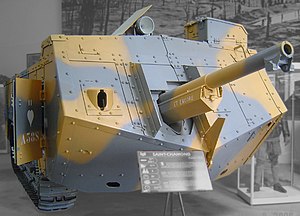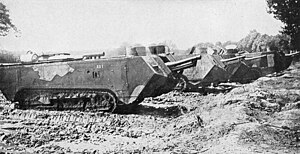Saint-Chamond (tank)
| ||||||||||||||||||||||||||||||||||
The Saint-Chamond was the second French heavy tank of the First World War. Overall an inadequate design born of the commercial rivalry with the makers of the Schneider CA1 tank. Three hundred and eighty Saint-Chamond tanks were manufactured but most of them were destroyed in action. World War 1 ended before the Saint-Chamond tanks were to be replaced by imported British heavy tanks.
Development
Originally the tank produced by Saint-Chamond was meant to be identical to the Schneider CA. Early 1916, the proposed definitive prototype of this latter tank was prepared in an army workshop. The type used tracks from the American-made Holt caterpillar tractors that were already employed in France for towing heavy artillery. Private Pierre Lescure designed the fighting compartment. Lieutenant Fouché lengthened the suspension to improve trench-crossing abilities. In this form the prototype of the Schneider was called the Tracteur A - not for security reasons, but because nobody knew exactly what to call such vehicles; the word char was not yet applied to tanks. However, Eugène Brillié, the chief designer working for the Schneider Company, rejected this prototype. He had invented a tail giving a shorter chassis providing the same trench crossing abilities for a lesser weight.
While Brillié began to design a second prototype (based on his earlier work on the Schneider CA-1), Schneider's main competitor, the arms manufacturer Forges et Aciéries de la Marine et d'Homécourt, based at Saint-Chamond, was given a second order for 400 tanks. First they intended to build the same tank as Schneider. However, Brillié refused to share his patented invention for free and Saint-Chamond refused to pay. So the latter company, not even having been given the blueprints of the new Schneider prototype, had to base its design on the original Tracteur A. Because of this the designs of the two companies began to diverge already, as the Tracteur A was longer.

Saint-Chamond's technical director was Colonel Émile Rimailho, an artillery officer who had become disatisfied over the insufficient reward he had received for helping design the famous Canon de 75 modele 1897 field gun as well as the Mle 1904 155 mm "Rimailho" howitzer . Following after his departure from the French State arsenal system (APX) and his joining Saint-Chamond, Emile Rimailho designed a 75 mm field gun, somewhat similar to the Mle 1897 75 mm gun he had co-designed with Sainte-Claire Deville. It was the proprietary "Canon de 75mm TR Saint-Chamond (Modele 1915)" otherwise designed to fire the regular French 75mm ammunition. Colonel Rimailho, who had a direct financial interest in selling his company's gun, induced the Ministry of War to specify that the new Saint-Chamond tank would also mount the Saint-Chamond made 75. In so doing he had also upstaged the Schneider CA1 tank which could only accommodate a very short Schneider made 75mm gun firing only reduced charge ammunition. To accommodate a regular length 75mm field gun, a longer hull than on the Schneider tank was needed. The first prototype, now quite distinct from the Schneider, was ready in September 1916. Later on, during 1917, the standard Canon de 75 modèle 1897 field gun eventually replaced the Rimailho designed gun.
When Colonel Jean Baptiste Eugène Estienne, who had taken the initiative to create the French tank arm, learned of the order for 400 tanks more, he was at first very gratified. When it later became clear however they would be of a different tank type, he was shocked and wrote: "I am painfully surprised that an order has been launched of this importance without asking the opinion of the only officer who, at the time, had undertaken a profound study of the technical and military aspects involved and who had brought the supreme commander to the decision to take this path [towards a tank arm]."[1]
Description

As a result of Rimailho's manipulations, the new tank had become a rather cumbersome vehicle. It had no rotating turret, but a large overhanging front compartment housing the long 75 mm gun, protruding from the nose. Within the forward fighting compartment and on the left was the driver, who was also the vehicle commander. On the right a machine gunner operated the front Hotchkiss machine gun. This machine gunner was also responsible for the breech operation of the 75mm gun which he had to perform after pivoting on his seat to the left. A loader (referred to in some sources as the gunner) adjusted the gun's elevation, observing the target through a small hatch in the front of the tank, which left him vulnerable to enemy fire. Traversing the 75mm gun implied traversing the whole tank and this was performed by the driver acting on the tank's individual track controls. A second fighting compartment at the back held one machine gunner next to the secondary driver position, from where the tank could also be driven backwards by the mechanic in an emergency. Between those two compartments stood the wholly accessible gasoline engine and electric generator. Narrow passageways on both sides of the engine connected the front and rear compartments. Those pasageways were also occupied by lateral Hotchkiss machine gun positions, one on each side and in front of the engine. Altogether, the Saint-Chamond had 4 Hotchkiss M1914 machine gun positions : one in the front, one in the back and one on each side of the tank.
Despite weighing 23 tons, the tank could manage a top speed of 12 km/h. This speed was seldom achieved in the field as the long nose was prone to dig into the ground. The relatively high maximum speed on flat ground was made possible by a "Crochat Collardeau" transmission which coupled a Panhard-Levassor 4 cylinders 90HP gasoline engine with an electric generator capable of giving an output of 260 amperes under 200 volts. The generator was connected to two separate electrical motors, one for each track, thus permitting perfect gradual steering of the tank . Due to its short tracks and over extended body, the vehicle experienced major difficulties in crossing trenches and overcoming obstacles . This led to such negative reactions by the first crews in training, that a special mention was passed on to General Headquarters: Nobody wants to serve on the Saint-Chamond. Second Lieutenant de Gouyon, principal Saint-Chamond driving instructor at Marly, has publicly declared that it has become virtually impossible for him to continue to carry on and, since he is a Member of Parliament, that he will request to have the whole matter placed on the next parliamentary agenda.[2]
Variant
Originally the crew of eight men was protected by 11 mm of steel armour. The addition of an extra layer of spaced 8.5 mm armour on the front improved protection. The roof was also redesigned with a double slope so that satchel charges and grenades would slide off. The original three observation cylinders in front and on top were done away with and replaced by a single low profile square turret permitting front vision by the tank's driver who was also the commander. With time, the tracks were also widened in two steps from 324mm to 412mm to lower their pressure on the ground.
Initially, forty eight Saint-Chamond tanks were modified as supply and recovery vehicles that could tow the lighter Schneider tanks. Later on, their first action as a fighting vehicle took place at Laffaux Mill on May 5, 1917. Sixteen Saint-Chamond tanks were engaged there , several of them getting stuck in various trenches, but only three were destroyed in combat. During the rest of the war, twelve groups in total were formed with Saint-Chamond tanks : Artillerie Spéciale No's 31-42. The Saint-Chamond's last engagement in battle, with initially 15 tanks, took place in October 1918, in support of the U.S. First Division near Montfaucon. However, by that time, the Renault FT tank had successfully taken over the major role in the French tank force and had also been purchased by the American Expeditionary Forces (A.E.F) in France .
Production slowed down in March 1918, after at least 377 had been manufactured. During the summer of 1918, since combat had left the trenches for the open fields, it was used to engage German field gun batteries (Nahkampfbatterien) at a distance with its 75mm cannon. In that particular role as an assault gun , the Saint-Chamond became at last quite effective.
After the 165th vehicle the common, and less expensive, Model 1897 field gun was used instead of Rimailho's (profitable) 75mm Saint-Chamond gun. At about the same time , barrel-like rollers were also added underneath the front and rear of the tank to facilitate crossing trenches. This improved version was later called, sometimes, the Modèle 17 although this identifier was not in official use.
After the war 54 were rebuilt as ammunition carriers; the remainder scrapped. There are unsubstantiated stories about Poland using the tank against the Red Army in 1920. If true these specimens were in all probability not from the Soviet Army - the latter never had been supplied with them and the French Expedition Forces to Russia were only equipped with the Renault FT. The last Saint-Chamond tank remaining in existence, alongside other French tanks of World War I ( Schneider CA1 and Renault FT ), is preserved at the Musée des Blindés at Saumur. It had survived, together with a Schneider CA1 tank of the same vintage, at the Aberdeen Proving Grounds Ordnance Museum in Maryland, USA, and was later donated by the U.S. to the French government . Although very well preserved now, it could not been restored to full self-propelled running condition by the Musee des Blindes, due to the irreversibly degraded condition of the original electric power systems.
References
- ^ Mathieu Detchessahar and Yannick Lemarchand, "Des Hommes et des Projects dans l'Urgence — La naissance du char d’assaut français, Annales des Mines p 47; quoting Lettre d’Estienne à Joffre, 1er novembre 1916. SHAT, 16 N 2121: « Je suis péniblement surpris qu’on ait lancé une commande de cette importance sans prendre l’avis du seul officier qui, à l’époque, se soit livré à une étude approfondie de la question technique et militaire, et qui ait décidé le général en chef à marcherdans cette voie »
- ^ Mathieu Detchessahar and Yannick Lemarchand, "Des Hommes et des Projects dans l'Urgence — La naissance du char d’assaut français, Annales des Mines p 47; quoting Note résumant la question du matériel d’artillerie d’assaut, G.Q.G., 28 novembre 1916. SHAT, 16 N 2121
3.Steven J. Zaloga,"French tanks of World war 1 ",2010,Osprey Publishing, ISBN 978-1-84603-513-5

